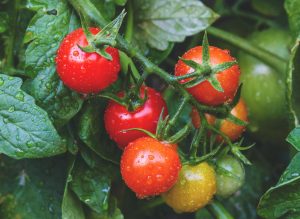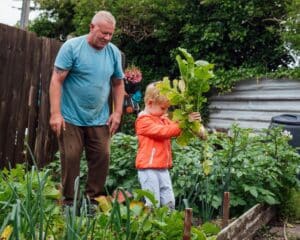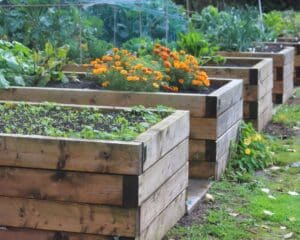
Tips for Fall Vegetable Gardening
Consider these tips for Fall vegetable gardening in Northeast Florida.
What to Grow
You may already have a productive warm-season garden and need to decide which cool-season crops you’ll now grow and where. It’s helpful to record the varieties you grew and include any notes you want to remember for the following seasons. It’s also important to rotate crops yearly to increase soil fertility and break the life cycle of disease organisms and pests. Our handouts “Planting Guide for North Florida Vegetables” and “Planting Guide for North Florida Culinary Herbs” can help you decide on your crops. Use the Plant Family column so you can avoid successively planting vegetables from the same family. Grow what your family likes to eat, and if it’s your first time, don’t try too much at once. You can also plant small amounts in 2-week intervals to keep a manageable amount coming.
When to Grow
Bush, lima, pole beans, summer and winter squash, and cucumber can still be grown. Additionally, you can renovate your garden to prepare for the cool season crops, along with a second crop of tomatoes, eggplants, and peppers. Start your Cool-weather seed crops in late August. Turnips, carrots, celery, and onion sets are all best planted directly into the garden. You can also start seeds either in-ground or starter pots of beets, broccoli, brussels sprouts, cabbage, cauliflower, Chinese cabbage, endive, kale, collards, and mustard (take a little extra care if transplanting mustards instead of direct sowing). You can plant Arugula, kohlrabi, lettuce, radish, spinach, strawberries, and swiss chard in September. Many herbs we typically grow prefer the cool season planting, including parsley, sage, cilantro, dill, fennel, chervil, and thyme.
Where to Grow
If you don’t have a garden location, choose the sunniest site on your property. Account for any deciduous trees that may block light when leafing out. Easy access to the kitchen is a plus. If the land has some slope and you garden in rows, align the rows perpendicular to the slope to decrease runoff. Otherwise, align them east to west for best sun exposure. Also, remember that taller plants like tomatoes or trellised plants should be located where they won’t block the sun from shorter plants.
How to Grow
If you’ve already created a vegetable garden, clean out the spent summer crops and remove any other debris. Don’t compost anything that looks diseased, as the heat may not kill certain diseases and nematodes. Reinforce raised bed structures if needed, or clean up the boundaries of your beds. A soil test would be advisable and typically available for free at your County Agricultural Extension offices. Based on the test, add the recommended amount of fertilizer. Next, add organic matter. Compost improves soil and plant growth regardless of the soil type you’re adding it to. Spread a 3-4 inch over the bed and lightly work in.
If you need to create a garden, the most productive and attractive way to grow a garden, especially in our area where soils lack nutrients and good texture, is to build raised beds. There are many advantages to a raised bed, and one of the biggest is that it doesn’t involve tilling. Tilling has become less popular in the home garden – it contributes to topsoil loss, can increase weeds by bringing seeds up where they will germinate and destroys the soil structure and the beneficial organisms. Many sites describe building a raised bed (for example, the UF document ENH1211). They can be built any size, but limiting them to 4” wide allows you to reach from both sides without walking into the bed. Raised planters complement square-foot gardening, first proposed by Mel Bartholomew, which has become a popular and efficient way to garden.
Create Your Bed
Once you’ve located your garden and built raised beds, it’s time to create your soil mix. A 1-1-1 mix (by volume) of compost, peat moss, and vermiculite makes the perfect soil. If you don’t already compost, combine different kinds of store-bought compost to ensure you’re putting a variety of nutrients into the mix. Once the planters are filled, mark off 1’ by 1’ squares with a sturdy grid. 
Plant your Garden.
Before planting, spray the soil to moisten it thoroughly. Seed packets will list the sowing depth, but generally, seeds are planted at a depth about equal to their size or a little deeper. Position trellises as you plant transplants. Lightly water your new plants or seeds and keep them moist. With the right soil mix in the garden, fertilizer is less necessary, as nutrients are added when additional compost is refreshed at the end of the season. Keep your beds tidy and watered. A serpentine soaker hose running through the bed beneath the soil surface is an efficient, water-wise practice. Hand watering can supplement the irrigation regulated by the SJRWMD. Check on your garden daily and harvest often.
From our office in Atlantic Beach and satellites throughout Northeast Florida, Rockaway Inc proudly serves both commercial and residential landscape design, maintenance, lawn care, irrigation, and outdoor living carpentry client needs in Jacksonville, St Augustine, Atlantic Beach, Neptune Beach, Jacksonville Beach, Ponte Vedra, Nocatee, St. Johns, and Fernandina Beach.
References
Bartholomew, M.l, 2013, All New Square Foot Gardening, 2nd edition, Cool Springs Press, Minneapolis, MN, 272 pp.
DelValle, T.B., Gardening in Raised Beds, ENH1211/EP472, Gainesville: University of Florida Institute of Food and Agricultural Sciences, July 2016.
